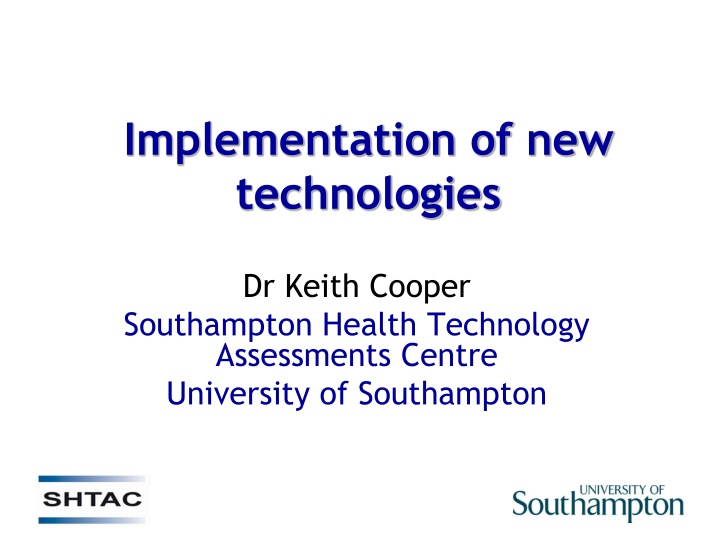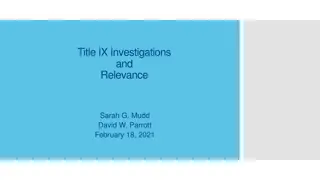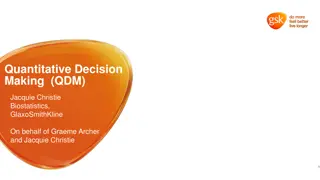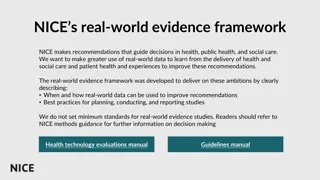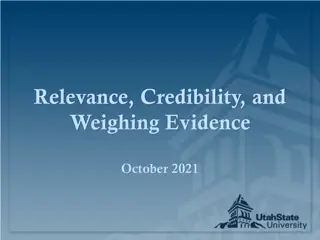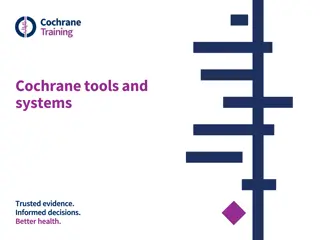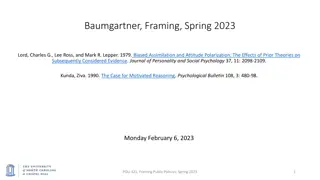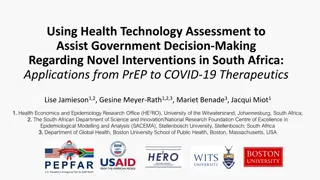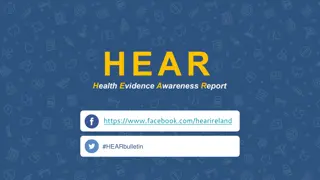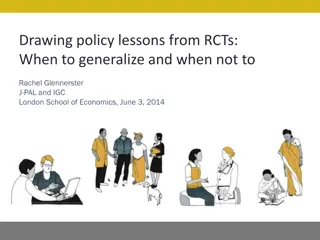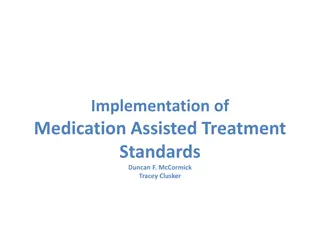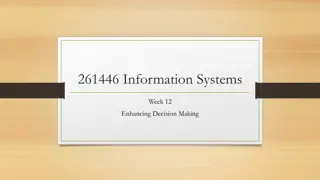Evidence-Based Decision Making for Health Technology Implementation
The implementation of new technologies in healthcare must be evidence-based and cost-effective. Health Technology Assessment (HTA) plays a crucial role in evaluating the effectiveness, cost, and comparative benefits of various health technologies. Organizations like NICE provide guidance based on clinical and economic evidence to ensure the efficient use of healthcare resources. Decision-making is guided by factors such as cost-effectiveness and quality-adjusted life years. Machine perfusion systems versus cold static storage for kidney transplantation is an example discussed in the context of NICE technology appraisal guidance.
Download Presentation

Please find below an Image/Link to download the presentation.
The content on the website is provided AS IS for your information and personal use only. It may not be sold, licensed, or shared on other websites without obtaining consent from the author.If you encounter any issues during the download, it is possible that the publisher has removed the file from their server.
You are allowed to download the files provided on this website for personal or commercial use, subject to the condition that they are used lawfully. All files are the property of their respective owners.
The content on the website is provided AS IS for your information and personal use only. It may not be sold, licensed, or shared on other websites without obtaining consent from the author.
E N D
Presentation Transcript
Implementation of new technologies Dr Keith Cooper Southampton Health Technology Assessments Centre University of Southampton
Structure of talk Introduction Background to evidence based decision making for implementing new technologies Example: Machine perfusion preservation vs. cold storage in kidney transplantation
Introduction Within health care systems there is limited resources and increasing demand on services Choices need to be made in a fair and equitable manner Choice A Choice B
HTA modelling Health Technology Assessment aims to evaluate health technologies by investigating: whether the technology works for whom at what cost how it compares with the alternatives A health technology can be any intervention that improves health and includes medications, devices, hospital procedures, health promotion activities and diagnostic tests Health Technology Assessment in the UK is overseen by the NIHR HTA programme Provides Technology Assessment Reports for NICE
NICE (National Institute for Health and Clinical Excellence) Provides guidance to NHS on new technologies, promote clinical excellence and the effective use of resources within the NHS. Recommendations are based upon Clinical evidence: systematic review, meta analyses Economic evidence: cost effectiveness models Bases decision-making on Technology Assessment Reports (TARs) and manufacturer submissions TARs produced by university departments, such as Southampton Health Technology Assessments Centre (SHTAC) New technologies are most often more effective and more costly is it good value for money to adopt?
NICE decision making Cost effectiveness Costs and health benefits are estimated for patients on alternative treatments Health benefits are in term of Quality Adjusted Life Years Life expectancy + Quality of life Compare new treatment with existing treatment(s) NICE is more likely to recommend a treatment if its cost effectiveness is lower than CE threshold ( 30,000 per QALY)
Machine perfusion systems and cold static storage of kidneys from deceased donors NICE technology appraisal guidance [TA165] Published date: January 2009 Assessment group report by PenTAG, university of Exeter (Bond, Pitt, Akoh, Moxham, Hoyle, Anderson)
What is the best method of preservation for kidneys for transplantation? Cold storage solutions the kidney is flushed through with a sterile preservation solution and is kept on ice in a box before transplantation Marshall's hypertonic citrate (Soltran, Baxter Healthcare) and Belzer UW (Viaspan, Bristol Myers Squibb) Machine perfusion systems Machine perfusion systems continuously pump cold preservation solution through the kidney The LifePortTM kidney transporter (Organ Recovery Systems), RM3 renal preservation system (Waters Medical Systems)
Clinical evidence Machine Preservation Trial (Moers, 2008) Cold storage (Viaspan) N= 336 26.5% PPART study (Watson 2010) Cold storage N = 45 Machine perfusion (Lifeport) N = 336 20.8% Machine perfusion (Lifeport) N = 45 58% Proportion of delayed graft function following transplant Proportion of primary non function Graft survival at 1 year 56% 4.8% 2.1% 0% 2% 90% 94% 98% 93.3%
Other model parameters (costs) Parameter Storage cost per Kidney: Cold storage (ViaSpan) Value 262.33 Machine perfusion (LifePort) 736.55 Other costs Transplant cost Dialysis cost (per month) Post transplant cost (month 1-3) Post transplant cost (month 4-12) 16,413 2052 2463 1385
Other model parameters (QALY) Quality of life values (age 50 years) Transplant state: 0.75 Dialysis state: 0.63
Cost effectiveness results Results using MPT data (Moers 2008) Cold storage (ViaSpan) Machine perfusion (LifePort) 139,110 Difference Costs per patient 142,805 Health benefits (QALYs) 9.58 9.79 0.22 Preferred technology -3695 Machine perfusion Results using PPART data (Watson 2010) Costs per patient Health benefits (QALYs) 9.19 9.13 -0.06 Preferred technology Cold storage (ViaSpan) Machine perfusion (LifePort) Difference 139,205 141,319 2114 Cold storage
NICE recommendations The overall costs and benefits associated with kidney transplantation using either machine perfusion or cold static storage were similar. The Committee recommended that the LifePort kidney transporter be considered as an alternative to cold static storage solutions. The choice of which to use would depend on clinical and logistical factors within both the retrieval team and transplant centres.
NICE recommendations further research The Committee considered that it was important for transplant centres to collect standardised and comprehensive data that follow up the outcomes for kidneys stored using different methods.
Conclusions Unclear from current data (2009), whether machine perfusion preferable to cold storage Depends upon trial data used Difficult to show difference in clinical outcomes Large RCT is needed which may not be practical Other more recent studies have come to different conclusions Gomez et al 2012 MP is cost effective Groen et al 2012 MP cost saving Jochmans 2015 (Transplant International) provides excellent overview of current evidence
